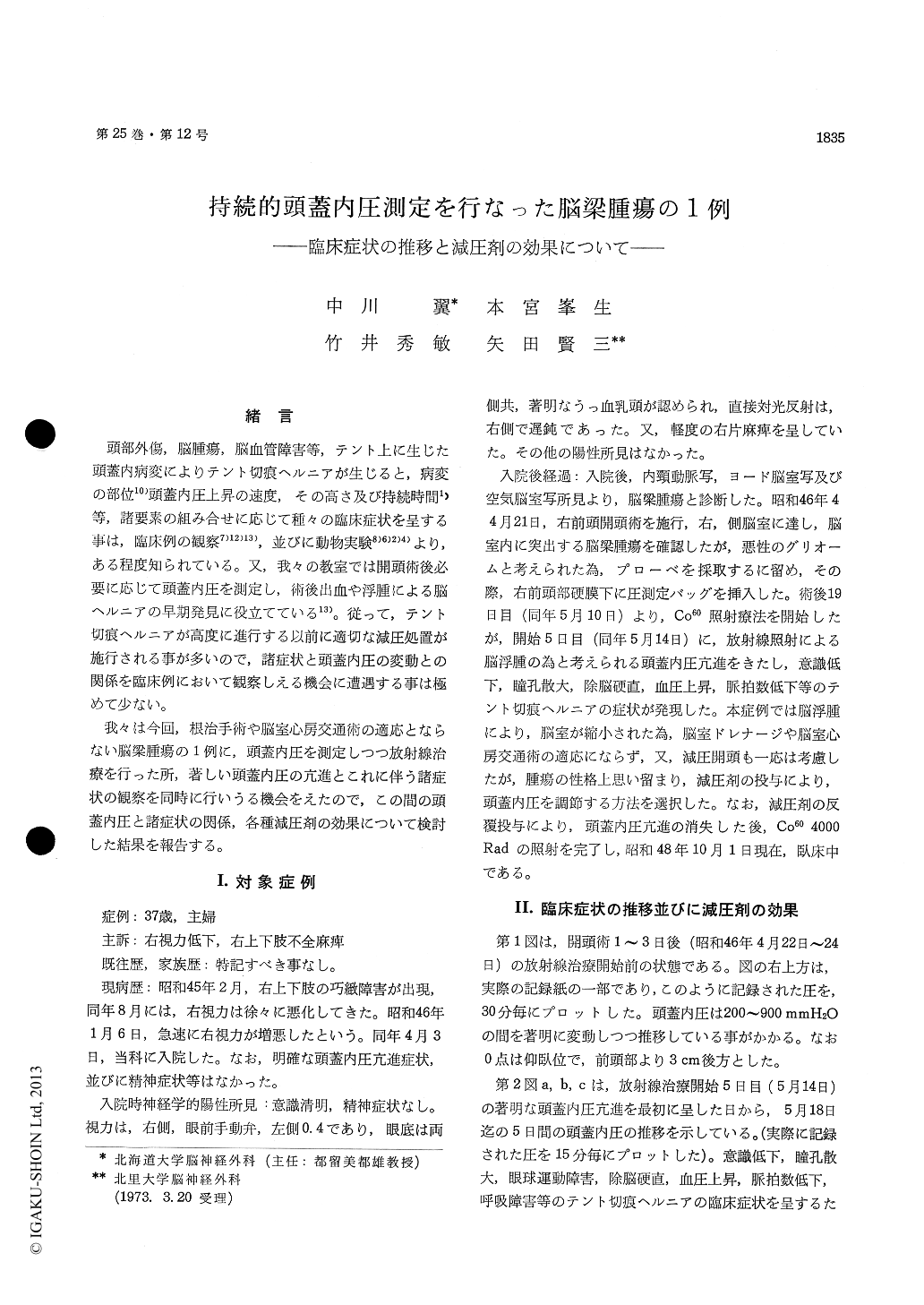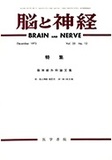Japanese
English
- 有料閲覧
- Abstract 文献概要
- 1ページ目 Look Inside
緒言
頭部外傷,脳腫瘍,脳血管障害等,テント上に生じた頭蓋内病変によりテント切痕ヘルニァが生じると,病変の部位10)頭蓋内圧上昇の速度,その高さ及び持続時間1)等,諸要素の組み合せに応じて種々の臨床症状を呈する事は,臨床例の観察7)12)13),並びに動物実験8)6)2)4)より,ある程度知られている。又,我々の教室では開頭術後必要に応じて頭蓋内圧を測定し,術後出血や浮腫による脳ヘルニアの早期発見に役立てている13)。従って,テント切痕ヘルニアが高度に進行する以前に適切な減圧処置が施行される事が多いので,諸症状と頭蓋内圧の変動との関係を臨床例において観察しえる機会に遭遇する事は極めて少ない。
我々は今回,根治手術や脳室心房交通術の適応とならない脳梁腫瘍の1例に,頭蓋内圧を測定しつつ放射線治療を行った所,著しい頭蓋内圧の亢進とこれに伴う諸症状の観察を同時に行いうる機会をえたので,この間の頭蓋内圧と諸症状の関係,各種減圧剤の効果について検討した結果を報告する。
Although various neurological signs and symp-toms caused by tentorial herniation have been described in details, only little has been known in relation to actual supratentorial intracranial pres-sure (ICP). The main reasons are ; 1). It is not a routine procedure in most of neurosurgical department to record ICP continuously. 2) In most of the cases, prompt action is taken to treat the cause of elevating ICP. And therefore, it is a rare occasion to be able to observe these signs and symptoms in correlation to supratentorial ICP for a long period of time.
The case presented here is a 37 years old house-wife who was admitted to our department on April 3, 1971 with chief complaints of visual disturbance and slight hemipares is on the right side. On admis-sion, she showed marked bilateral papilledema and slight hemiparesis is on the right side. Angiograms and air studies revealed a large tumor of the corpus callosum. Exploratory craniotomy was carried out on April 21. The tumor was infiltrating type and widely involving almost entire nnrmis nallnsnm.At the time of operation, a small rubber balloon was placed in the subdural space to record intrac-ranial pressure (ICP) continuously. ICP during the 1st and 3rd postoperative days is shown in fig. 1.
On May 14, or 5th day following to initiation of radiotherapy, the patient developed signs of tentorial herniation, which was thought to be due to radiation cerebral edema. Because of the ma-lignancy of the tumor, and also because of the small sized ventricles, conservative method to re-duce ICP was selected. As shown in fig. 2a, b and c, each time when he patient showed clinical signs of tentorial herniation, either 20% mannitol solution intravenously or 50% glycerol intraorally was given. Fig. 3 and 4 show the relationship between ICP level and various clinical signs. Fig. 5 shows the effect of various agents on ICP.
Conclusions ;
(1) Among the various signs which appear when the tentorial herniation develops, dilatation of the pupils and decerebration were most dominant, while only a little change was noted in the vital signs in this case. This means that relatively little distortion of the brainstem took place in this particular case.
(2) Dilation of pupils appeared when ICP ranged 1000 to 1200 mm H2O lasted for 40 to 50 minutes, or ICP ranged 500 to 1200 mm H2O lasted for 70 to 120 minutes.
(3) The amount of hypertonic solution can be minimized by giving the solution by observing ICP continuously.

Copyright © 1973, Igaku-Shoin Ltd. All rights reserved.


